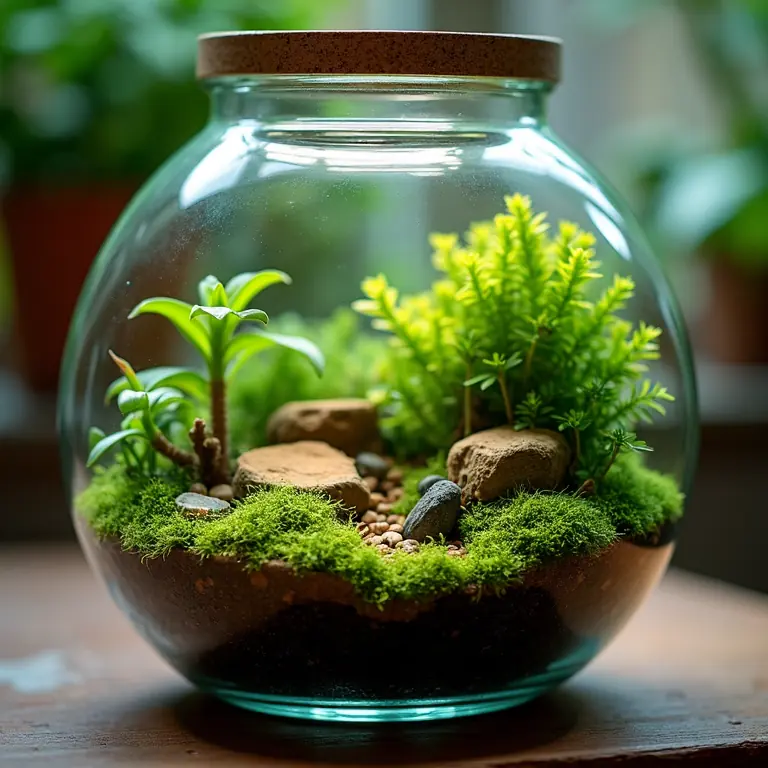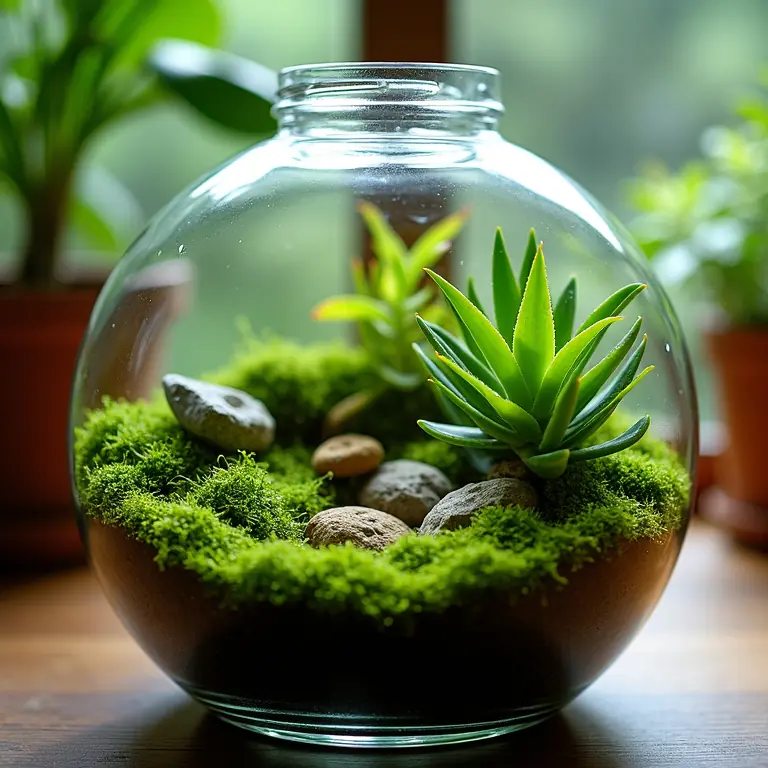Build Your Own Terrarium: A Friendly Guide to Miniature Ecosystems
Have you ever dreamed of having a little slice of nature indoors, a miniature world thriving on your windowsill? Well, you’re in the right place! Building a terrarium is a wonderfully rewarding project that combines creativity, botany, and a touch of patience. This guide will walk you through everything you need to know to create a beautiful, self-sustaining ecosystem – no green thumb required (though it might inspire one!).
What *is* a Terrarium, Anyway?
The word “terrarium” comes from the Latin word “terra,” meaning earth. Essentially, a terrarium is a contained environment for growing plants. Think of it as a tiny garden within glass (or plastic!). They come in all shapes and sizes, from small jars to large fish tanks. There are two main types:
- Closed Terrariums: These are sealed environments, creating a self-sustaining ecosystem where water cycles naturally. They’re ideal for plants that thrive in high humidity.
- Open Terrariums: These have an opening, allowing for more air circulation. They’re better suited for plants that prefer drier conditions, like succulents and cacti.
We’ll focus primarily on closed terrariums in this guide, as they’re a fantastic starting point and demonstrate the fascinating principles of ecological balance. But the basic principles apply to open terrariums too, just with some adjustments.
Why Build a Terrarium? The Benefits are Blooming!
Beyond just being aesthetically pleasing, terrariums offer a host of benefits:
- Low Maintenance: Once established, closed terrariums require very little watering or care.
- Educational: They’re a fantastic way to learn about ecosystems, plant life cycles, and the water cycle.
- Air Purification: Plants naturally filter the air, improving indoor air quality.
- Stress Relief: Gardening, even on a miniature scale, is known to be therapeutic and relaxing.
- Creative Outlet: Terrariums are a blank canvas for your creativity! You can design unique landscapes and express your personal style.
Gathering Your Supplies: The Terrarium Toolkit
Before you start building, you’ll need to gather a few essential supplies. Don’t worry, most of these are readily available at garden centers, craft stores, or even around your home.
- Container: This can be anything clear – a glass jar, a fishbowl, a repurposed vase, a cookie jar… Get creative! Wider openings make planting easier.
- Gravel or Pebbles: For drainage. About 1-2 inches depending on the size of your container.
- Activated Charcoal: This is crucial for closed terrariums. It filters toxins and keeps the environment fresh. Horticultural charcoal is best.
- Terrarium Soil Mix: A well-draining mix is essential. You can buy pre-made terrarium mix or create your own (see section below).
- Plants: Choose small, slow-growing plants suited to the terrarium environment. (See section below for recommendations).
- Decorative Elements: Moss, rocks, driftwood, figurines – let your imagination run wild!
- Tools: Long-handled tweezers, a spoon, a spray bottle, and a small brush can be helpful for planting and arranging.
Making Your Own Terrarium Soil Mix
If you prefer to make your own soil mix, here’s a simple recipe:

- 1 part peat moss or coco coir (for moisture retention)
- 1 part perlite or vermiculite (for aeration)
- 1 part horticultural sand (for drainage)
Mix these ingredients thoroughly. The exact ratios can be adjusted based on the plants you choose.
Choosing the Right Plants: A Miniature Jungle
Selecting the right plants is key to a thriving terrarium. Here are some excellent choices for closed terrariums:
- Ferns: Maidenhair ferns, button ferns, and asparagus ferns are all good options.
- Mosses: Sheet moss, cushion moss, and mood moss add a lush, natural look.
- Peperomia: These come in a variety of textures and colors and are relatively low-maintenance.
- Fittonia (Nerve Plant): Known for their striking vein patterns.
- Pilea: The Friendship Plant is a charming addition.
- Selaginella: Spikemosses thrive in humid environments.
- Cryptanthus (Earth Star): These bromeliads add a touch of color and texture.
Important Considerations:
- Size: Choose plants that will remain relatively small. You don’t want them to outgrow your terrarium quickly.
- Growth Rate: Slow-growing plants are ideal.
- Humidity Preference: All plants in the terrarium should have similar humidity requirements.
- Compatibility: Research plant compatibility to avoid any conflicts.
For open terrariums, succulents and cacti are excellent choices. Echeverias, Haworthias, and Sedums are all popular options.
Building Your Terrarium: Step-by-Step Instructions
Now for the fun part! Let’s build your terrarium. Follow these steps carefully:

- Clean Your Container: Ensure your container is thoroughly clean and dry.
- Add the Drainage Layer: Pour a layer of gravel or pebbles into the bottom of the container. This provides drainage and prevents the roots from sitting in water.
- Add the Activated Charcoal: Sprinkle a layer of activated charcoal over the gravel. This helps filter toxins and keep the terrarium environment healthy.
- Add the Soil Mix: Add a layer of terrarium soil mix on top of the charcoal. The depth of the soil will depend on the size of your plants.
- Plant Your Plants: Gently remove the plants from their pots and loosen the roots. Create small holes in the soil and carefully plant the plants. Use tweezers or a spoon to help position them.
- Add Decorative Elements: Arrange moss, rocks, driftwood, and any other decorative elements to create your desired landscape.
- Water Gently: Lightly mist the soil with a spray bottle. Avoid overwatering.
- Clean the Glass: Wipe down the inside of the glass to remove any soil or debris.
Here’s a helpful video demonstrating the process:
Terrarium Care: Keeping Your Miniature World Thriving
Once your terrarium is built, it requires minimal care. Here are some tips:
- Light: Place your terrarium in a location with bright, indirect light. Avoid direct sunlight, which can overheat the terrarium.
- Watering: Closed terrariums need very little watering. The water cycle should maintain adequate moisture. If the soil looks dry, mist lightly with a spray bottle. If condensation is excessive, remove the lid for a few hours to allow some moisture to evaporate.
- Pruning: Trim any leaves that turn yellow or brown. Prune plants if they start to outgrow the terrarium.
- Ventilation: Occasionally open the lid of a closed terrarium for a few hours to allow fresh air to circulate.
- Fertilizing: Terrariums generally don’t require fertilization. If you do fertilize, use a very dilute liquid fertilizer.
Troubleshooting: Addressing Common Terrarium Issues
Even with the best care, you might encounter a few issues. Here’s how to address them:
- Mold: Mold can grow in humid environments. Remove any moldy leaves or debris and improve ventilation. Activated charcoal helps prevent mold growth.
- Yellowing Leaves: Yellowing leaves can be caused by overwatering, underwatering, or lack of light. Adjust your watering schedule and move the terrarium to a brighter location.
- Brown Leaves: Brown leaves can be caused by dry air, direct sunlight, or fertilizer burn.
- Leggy Growth: If plants are stretching towards the light, they’re not getting enough. Move the terrarium to a brighter location.
Beyond the Basics: Terrarium Design Ideas
Now that you know the fundamentals, let your creativity shine! Here are some ideas to inspire you:
- Desert Terrarium: Use sand, cacti, and succulents to create a miniature desert landscape.
- Forest Terrarium: Use ferns, moss, and driftwood to create a lush forest scene.
- Fairy Garden Terrarium: Add miniature figurines, houses, and pathways to create a whimsical fairy garden.
- Beach Terrarium: Use sand, shells, and small succulents to create a coastal scene.
- Zen Garden Terrarium: Use sand, rocks, and carefully placed plants to create a peaceful Zen garden.
Expanding Your Horticultural Horizons
Building a terrarium is just the beginning of your plant-related adventures! If you enjoy the delicate process of nurturing life, you might also find joy in:
- Gongfu Cha Ceremony: Learn about the art of tea preparation and the mindful practice of Gongfu Cha.
- Backyard Stargazing: Explore the wonders of the night sky and learn to identify constellations.
- Sourdough Baking: Discover the ancient art of breadmaking and cultivate your own sourdough starter.
Final Thoughts: Embrace the Miniature World!
Building a terrarium is a rewarding experience that brings a touch of nature indoors. It’s a chance to get creative, learn about ecosystems, and enjoy the beauty of plants. So gather your supplies, let your imagination run wild, and create your own miniature world! Don’t be afraid to experiment and have fun – that’s what it’s all about.


Discussion about this post